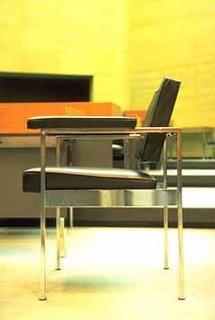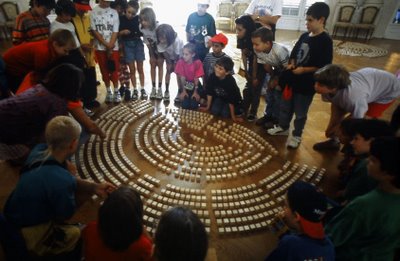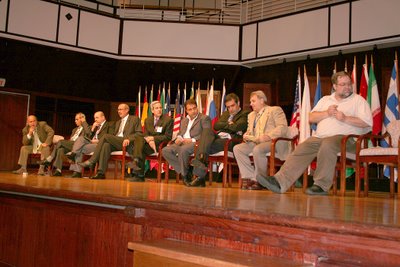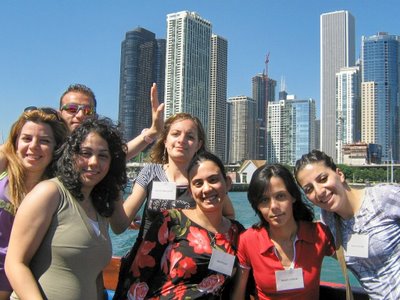 "Yum! Constitution Day is good for you!"
"Yum! Constitution Day is good for you!"
Discussing the meaning of the Constitution shouldn’t have to be nasty medicine, spooned down kids’ throats once a year. It should be enjoyable as well as educational, it should be valuable for grown-ups as well as students, and given the political challenges facing the country, it shouldn’t only happen one day a year.
This year the people of Indianapolis are being offered something much tastier than civic cod liver oil. We have a chance to create a new way to celebrate Constitution Day, and perhaps a new way to think about our shared cultural and political lives. “My Daily Constitution” is the brainchild of Los Angeles-based artist Linda Pollack. In a single week, from September 17 to 24, Hoosiers have a chance to engage in 19 different events devoted to the Constitution. Think of it as a civic Fringe Festival. The New York Times, in a section about adding a spoonful of sugar to help make the cod liver oil go down better for college students, had this to say about My Daily Constitution:
My Daily Constitution is a week-long, city-wide public art project dedicated to the collective exploration and interpretation of the United States Constitution. Conceptualized by Los Angeles-based artist Linda Pollack, the project uses dialogue, printed matter, film, poetry, theater and lectures to engage us all in creative reflection about democracy from many perspectives. My Daily Constitution treats Indianapolis as an integrated living being, layered with relationships, history, and expectations about citizenship, law, and the political state of the country … This project consists mainly of Constitution Cafés—ordinary community spaces where you can participate in democratic discussion—and programs that use the arts to reflect related ideas. A week of programming kicks off on Constitution Day, Sunday, September 17, and runs through Sunday, September 24.
Hold it, you may interrupt. Why is an artist doing this? What does art have to do with the US Constitution?
An easy answer would be that the physical appearance of the document that was adopted 219 years ago is strikingly beautiful, a work of art that deserves to be treated as such. See for yourself at the Indianapolis Museum of Art where, from September 1 to October 15, an original Dunlap and Claypoole printing of the Constitution will be displayed at the Lilly House. You can see what the American people first saw. You can stand in the presence of history.
 Of course the piece of parchment that you will see at IMA isn’t really THE Constitution. Lokk past the funny "f" instead of "s" printing and read very first line of the document: “We, the People … have ordained and established this Constitution for the United States of America.” It wasn’t 57 individuals in the sweltering Philadelphia State House who created the Constitution. It was, somehow, "the People" ... whoever "We" are. So for an understanding of the true art of the Constitution, we must look beyond this old piece of paper.
Of course the piece of parchment that you will see at IMA isn’t really THE Constitution. Lokk past the funny "f" instead of "s" printing and read very first line of the document: “We, the People … have ordained and established this Constitution for the United States of America.” It wasn’t 57 individuals in the sweltering Philadelphia State House who created the Constitution. It was, somehow, "the People" ... whoever "We" are. So for an understanding of the true art of the Constitution, we must look beyond this old piece of paper.
My Daily Constitution began in 2002 as a conceptual art project included in the exhibition “Democracy When?” at Los Angeles Contemporary Exhibitions in Hollywood. Linda Pollack was an internationally renowned artist who exhibited her work across Europe and the United States. With the Amsterdam based European Cultural Foundation in the 1990s she set up the Foundation's first arts mobility fund to respond to Europe's East/West cultural divide, facilitating over 900 art exchanges. She also set up initiatives addressing culture and war in the former Yugoslavia, working with the Sarajevo Theatre Festival, the Macedonian jazz-rockers Leb i Sol, and others.
What a depressing place to be, the Balkans in the 1990s! Linda witnessed the descent into brutal civil war, a descent driven by demagogic nationalist politicians appealing to the very worst instincts of The People.

In the Balkans, however, she also was struck by the sprouting and eventual flourishing of democracy in the everyday lives of citizens and communities.
Her experiences with new democracies in Balkan and East Europe led Linda to create a major installation called "German Parliaments." Germany in the 1990s was preoccupied with building democracy. This entailed reorganizing governmental power, both by digesting East Germany into what had been West Germany, and more subtly by redefining the power of Germany's regional parliaments vis-à-vis a unified national government in Berlin and vis-à-vis the institutions of an increasingly assertive and powerful European Union. "German Parliaments" shifted the focus from building (and destroying) political institutions to the actual built environment in which politics took place. The installation drew attention to the actual seats of power, the chairs and desks used by parliamentarians and other officials. 

The comfort of politicians' backsides may seem mundane, even trivial. But Karl Marx said of the boils on his bum that made writing his ferocious criticisms of capitalism a daily ordeal: "I hope the bourgeoisie will remember my carbuncles until their dying day." Perhaps if the benches at the British Museum had slightly better padding in Marx's day, the 20th century might have worked out differently. And perhaps all of us are better off if German politicians can rest their seats comfortably (and peacefully) in their seats of power.
The brilliance of "German Parliaments" was not its exploration of the physical "seats of power," however, so much as the spatial configuration of those seats. Parliaments and congresses are generally places of beauty: they are after all the temples in our civil religion of democracy, and we expect temples to reflect the glory of the Creator (in the case of republics, the glory of "We the People"). German regional parliaments are no exception: they are imposingly beautiful.
 The State Capitol of Saxony
The State Capitol of Saxony
Any teacher knows there's a big difference between students sitting in a circle or seated in neat rows facing the front. Rows convey order and obedience, lines of authority. Circles encourage discussion, they can be noisy and messy, and sometimes they can be enormously creative. The same is true for houses of parliament. The way seats are arrayed tells us something about the way policymakers view power. "German Parliaments" represented in miniature how the seats were arranged in the provincial parliaments in Germany. During her residency at the art center Schloss Solitude in Stuttgart, Linda examined the construction and organization of the plenary halls of state and federal parliaments for clues about how democracy was being embraced by German society after unification.
 "German Parliaments" installation in Solitude Palace in Stuttgart
"German Parliaments" installation in Solitude Palace in Stuttgart
I wish I could have seen this installation! Pictures capture a part of the beauty of the domino-sized seating arrangements. You can feel just how contingent power is. "If we rearranged these chair this way instead of that way, think how the nature of political discourse would change!" More intriguing are the pictures of German schoolchildren interacting with the installation. They understand how important seating arrangements are. And seeing children looming over a miniature regional German parliament is a healthy reminder of just how fragile representative democracy can be.
 German children examining "German Parliaments"
German children examining "German Parliaments"
With My Daily Constitution, Pollack turns her attention from the physical architecture of German parliamentary halls to the political and moral framework of the American constitution. The project came into being after Linda returned to the US, after 9/11, after the controversial adoption of the USA PATRIOT Act. During the frenzied discussions of vulnerabilities and protections, of constitutional rights and governmental abuses, Linda realized how little she knew about the Constitution, how little anyone seems to know. Linda's great act was not simply to complain about the government's abuses or about the public's ignorance, or to parallel Sen. Byrd's cod liver oil approach by forcing constitutional lessons down citizens' throats.
Where “German Parliaments” examined the static spatial structure of policymaking, My Daily Constitution creates new, fluid spaces where citizens can come together to discuss the challenges and possibilities of our shared civic life. My Daily Constitution is organized around a series of discussions, "Constitution Cafés," devoted to some aspect of democracy. Constitution Cafes occur in spaces that might not be considered usual forums to discuss politics: parks and museums, coffee shops and churches, bookstores and food courts.
 My Daily Constitution: An act of communal creation in Cincinnati
My Daily Constitution: An act of communal creation in Cincinnati
Let's return to the question posed earlier: Sure, Constitution Cafes are good for you, but are they art? The leading institutional sponsors of My Daily Constitution in Indianapolis are a museum (the Indianapolis Museum of Art) and an art school (IUPUI's Herron School of Art and Design) ... but that doesn't make it art, does it?
Perhaps the beauty of the physical spaces in which My Daily Constitution’s political discussions take place qualify them as art. The Statehouse, the Athenaeum, the Old Centrum ... No doubt about it, the venues are among the most gorgeous in the city. Check out the blurbs in IndyBuzz where you can see images of the sites. It makes sense to see the physical spaces in which Constitutional Cafés unfold as constituting part of the artwork themselves. This was the brilliant insight of "German Parliaments": the tactile world in which power is exercised is inextricably bound to the exercise of power itself.
It goes deeper than this. We humans are social beings who live life differently when we share space with other social beings like ourselves. One problem today is that so many distractions can draw us away from these real world social and communal engagements. For me it's TV and the computer, reading and listening to music by myself. As it becomes possible to conduct more of our social life at a distance, in cyberspace, it's absolutely essential that physical real-world places are worth our time and presence. Spaces must be truly special to attract us.
Constitution Cafés take this notion further. So many of our real-world interactions with our fellow human creatures -- work, business, school -- are routine and routinized, offering no scope for collective play or creation.
It thus isn't the aesthetics of the physical events that make My Daily Constitution itself art. It is the process of shared creation. The previous comparison with the Fringe Festival is apt but incomplete. Think of Big Car's brilliant Masterpiece in a Day, which on September 23 allows anyone to write a story, compose a song, paint a picture ... as long as it's finished by 3 PM.

We will have more time than this to create a matserpiece of civic discourse
Masterpiece-in-a-Day's particular pieces of artwork are less important than the experience, the communal acts of creativity. Likewise, more important than any particular flash of insight about democracy or brilliant observation about civil rights during a Constitution Cafés is the process of discussion. What matters is the coming-together of equals to create something new.
So when you attend a Constitution Café, or the Film Festival at IMA, or the public reading of the Constitution at the Statehouse on Constitution Day, or the democracy hip-hop poetry slam at Glendale Mall ... look around you. Feel the space as well as the conversation. My conversation with Andy Jacob's about the War Powers Clause will take place in the Indiana Historical Society's theatre, with 300 seats facing the stage. Contrast this with the mixed scattering of comfy chairs and folding chairs at the discussion of LGBT rights at Out Word Bound Bookstore. How does space shape the discussion? Where's the power focused?
This shows how complicated the relation between art and politics can be. The works of art we'll be creating in My Daily Constitution are open-ended. Discussion only for the sake of discussing is even more sterile than "art for art's sake." The conversations we start during the week of September 17th to 24th can’t stop the way the masterpieces-in-a-day will stop being created at 3 PM September 23rd. And the conversations begun during that week ought to have a telos, a purpose ... they should be directed toward making changes in our lives.
That's asking a lot of any work of art, even one as ambitious as My Daily Constitution. Perhaps the best way to think of this is less a finished work of art than an opportunity: Linda Pollack has provided Indianapolis with a civic studio, and now it’s up to us to create.
Some suggestions about My Daily Constitution. Check out at the week's schedule at the MDC website or IndyBuzz. Identify the Constitution Cafés that matter most to you, then branch out to similar topics. IndyBuzz identifies a few clusters of themes:
- Overarching events addressing the Constitution as a whole
- Constitution Cafés discussing free spech and its limits
- Constitution Cafés discussing the struggle to be included in "We the People"
- Constitution Cafés discussing tensions between private property and the social good
- Constitution Cafés discussing the Constitution in a time of war and terror
But dont stop there. Move outside your particular interests, and attend events that you may know or even care little about.
Any questions about this very special opportunity? Contact me at john@sipr.org.


















